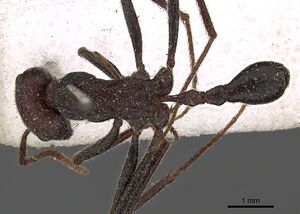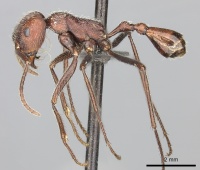Ocymyrmex sphinx
| Ocymyrmex sphinx | |
|---|---|

| |
| Scientific classification | |
| Kingdom: | Animalia |
| Phylum: | Arthropoda |
| Class: | Insecta |
| Order: | Hymenoptera |
| Family: | Formicidae |
| Subfamily: | Myrmicinae |
| Tribe: | Crematogastrini |
| Genus: | Ocymyrmex |
| Species: | O. sphinx |
| Binomial name | |
| Ocymyrmex sphinx Bolton, 1981 | |
Nests typically have a single entrance that opens into a vertical tunnel that terminates in a broad chamber at a depth of about 1.5 m from the surface. Other brood and food chambers branch off from the tunnel at various intermediate levels.
Identification
A member of the hirsutus group. At first glance this species appears to be a smaller version of Ocymyrmex picardi but, apart from being consistently smaller it has silvery body hairs where those of picardi are dark reddish brown to blackish, has much denser pilosity and pubescence on the propodeal dorsum and has much stronger, denser and more sharply defined ground-sculpture on the dorsum of the head than is seen in picardi. The cephalic sculpture of sphinx is much the same as that seen in Ocymyrmex monardi, but this latter species is much smaller and has the petiole node unsculptured. (Bolton 1981)
Keys including this Species
Distribution
Latitudinal Distribution Pattern
Latitudinal Range: -23.31667° to -26.34087°.
| North Temperate |
North Subtropical |
Tropical | South Subtropical |
South Temperate |
- Source: AntMaps
Distribution based on Regional Taxon Lists
Afrotropical Region: Botswana (type locality), South Africa.
Distribution based on AntMaps
Distribution based on AntWeb specimens
Check data from AntWeb
Countries Occupied
| Number of countries occupied by this species based on AntWiki Regional Taxon Lists. In general, fewer countries occupied indicates a narrower range, while more countries indicates a more widespread species. |

|
Estimated Abundance
| Relative abundance based on number of AntMaps records per species (this species within the purple bar). Fewer records (to the left) indicates a less abundant/encountered species while more records (to the right) indicates more abundant/encountered species. |

|
Biology
Forder and Marsh (1989) observed from dissections that the ergatoid like queens of this species have larger, and many more, ovaries than workers.
Castes
Images from AntWeb
   
| |
| Holotype of Ocymyrmex sphinx. Worker. Specimen code casent0900396. Photographer Ryan Perry, uploaded by California Academy of Sciences. | Owned by NHMUK, London, UK. |
Nomenclature
The following information is derived from Barry Bolton's Online Catalogue of the Ants of the World.
- sphinx. Ocymyrmex sphinx Bolton, 1981b: 278, fig. 21 (w.) BOTSWANA. Bolton & Marsh, 1989: 1278 (q.).
Unless otherwise noted the text for the remainder of this section is reported from the publication that includes the original description.
Description
Worker
Holotype. TL 9.3, HL 2.18, HW 2.04, CI 94, SL 1.96, SI 96, PW 1.32, AL 2.86.
Large species. Anterior clypeal margin with a conspicuous semicircular impression medially which is flanked on each side by a low but broad triangular tooth. Occipital margin feebly indented medially in full-face view. Maximum diameter of eye 0.43, about 0.21 x HW, the eyes distinctly failing to break the outline of the sides of the head in full-face view. Promesonotum rounded in profile, sloping posteriorly to the propodeum which is almost flat and which rounds evenly into the steep declivity. Metapleural lobes small, narrowly rounded and prominent, in absolute profile just visible behind the bulge of the projecting metapleural glands. Petiole node small and rounded in profile, the peduncle with a feebly convex area midway along its ventral surface but without a developed process. Petiole node in dorsal view distinctly broader than long, strongly developed, constricted behind at the posterior peduncle. Postpetiole about as broad as long in dorsal view, excluding the anterior articulatory portion. Base of first gastral tergite narrow, no wider than the postpetiole, but not forming as conspicuously narrowed a neck as is usual in this genus. Instead the gaster begins to widen gradually almost immediately behind its articulation with the postpetiole, the sides at first gradually and then more strongly divergent in dorsal view. Dorsum of head finely, densely and irregularly longitudinally rugulose everywhere, with dense conspicuous coarse punctulate to granular ground-sculpture between the rugulae. On the central strip of the dorsum the rugulae are most regular behind the frontal lobes, posteriorly they become narrowly vermiculate. Occipitally and laterally on the dorsum the rugulae are narrowly vermiculate everywhere and tend to arch outwards behind the eyes. Rugae on pronotal dorsum arched-transverse anteriorly. An area of longitudinal sculpture occurs between the mesothoracic spiracles, visible in paratypes, but in the holotype a pin is inserted at this point and the sculpture destroyed. Remainder of dorsal alitrunk and declivity coarsely transversely rugose. Petiole and its peduncle finely transversely rugose ventrally; behind the level of the spiracle the rugae continuing up the sides of the node and across the dorsum. Transverse rugae also present on dorsum of peduncle. Dorsum of postpetiole finely granular and matt. All dorsal surfaces of head and alitrunk densely clothed with hairs many of them quite short. Prop ode urn dorsally also with dense pubescence. Hairs on first gastral tergite very short and sparse. Colour a very dull dark red, the gaster black.
Paratypes. TL 9.5-10.1, HL 2.16-2.28, HW 2.08-2.14, CI 93-96, SL 1.95-2.06, SI 94-98, PW 1.38-1.44, AL 2.90-3.02 (12 measured). Maximum diameter of eye 0.44-0.46, about 0.20-0.22 x HW. As holotype but some showing shorter pilosity than others, apparently due to the hairs having been broken off.
Type Material
Holotype worker, Botswana: 18 miles [29 km] NE. of Kalkfontein, 12-13.iv.l972, no. B3 (M. C. Day) (The Natural History Museum). Paratypes. Botswana: 19 workers, Kuke Pan, 26.iii.1930, Vernay-Lang Kalahari Expd. (G. U. Son) (Museum of Comparative Zoology, BMNH, NM - Bulawayo).
References
- Bolton, B. 1981. A revision of six minor genera of Myrmicinae (Hymenoptera: Formicidae) in the Ethiopian zoogeographical region. Bulletin of the British Museum (Natural History) Entomology. 43:245-307. (page 278, fig. 21 worker described)
- Bolton, B. and A. C. Marsh. 1989. The Afrotropical thermophilic ant genus Ocymyrmex (Hymenoptera: Formicidae). Journal of Natural History. 23:1267-1308. (page 1278, queen described)
References based on Global Ant Biodiversity Informatics
- Bolton B. 1981. A revision of six minor genera of Myrmicinae (Hymenoptera: Formicidae) in the Ethiopian zoogeographical region. Bulletin of the British Museum (Natural History). Entomology 43: 245-307.
- Bolton B., and A. C. Marsh. 1989. The Afrotropical thermophilic ant genus Ocymyrmex (Hymenoptera: Formicidae). Journal of Natural History 23: 1267-1308.
- IZIKO South Africa Museum Collection

